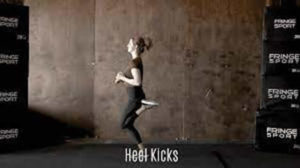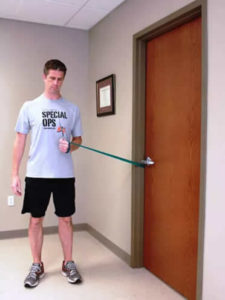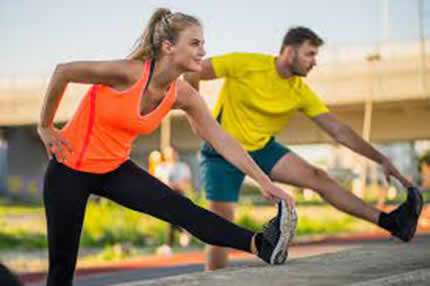by: Marie Serrado
With Summer fast approaching, it’s a great time to be engaging in outdoor activities with loved ones and engaging in sports. Although, it’s also a time to remember all the injuries you can sustain. It’s essential to remember ways you can both prevent and condition your body from being injured and missing out on all the fun!
- Warm-Up Routines
When starting any exercise, warming up your body is always important. Warming up your body allows the muscles to prepare better while allowing blood to flow to the muscles and loosen up joints. When starting a warm-up routine, it’s always best to start slow and slowly build your way up. For instance, if you are playing soccer., heel kicks are a great warm-up! Otherwise, you might tire yourself out or cause yourself an injury.
For heel kicks:
-
- Start standing with your feet shoulder-width apart and your neck and spine erect. Your hands are at your sides.
- Shift your weight to your right foot, and in a quick movement, bring your left foot back behind you so your heel gets as close as possible to your glutes. Keep your left knee pointed down and move your thigh as little as possible.
- Bring your left foot back down to rest flat on the ground, and repeat the same backward kicking motion for your right foot.
- Keep repeating this alternating motion in a ‘running in place’ movement. Your arms can bend up and out in front of you to help maintain your balance.
- Start slow and work your way up to a faster pace and a greater degree of force as you get better at the movement.

- Flexibility and Mobility
Stretching is also a great way to warm up your body. It also helps improve flexibility and increase the range of motion. An example of a good stretch workout would be a side lunge stretch! You should never do any activity without ensuring you are adequately stretched, as this can increase the risk of sustaining an injury or pulling a muscle.
For Side Lunge Stretches:
-
- Keep your upper body straight and legs apart. Then shift your weight in a slow “lunge” to the side over a bent knee (not forward, as in a typical lunge). You should feel a stretch along the opposite leg’s inner thigh, which should be straight as you push your weight to the bent-knee side.
- Try to hold it for 20 to 30 seconds on each side.

- Lower Body Condition:
Conditioning the lower body can help prevent injuries to the legs, ankles, and knees. With lower body condition, it helps with balance, and it also helps strengthen your lower body as well. A few good lower-body exercises would be squats and lunges.
- Upper Body Strength.
You must have excellent upper body strength when doing outdoor activities like basketball, football, or baseball. Some upper body exercises include push-ups, pull-ups, and shoulder presses to help increase strength and stability. Upper body strength can also help prevent injuries, along with pulling shoulder joints—resistance band exercises for the rotator cuff muscles to support the shoulder joint and prevent common injuries. An example of this would be internal shoulder rotation!
For internal shoulder rotation:
To do the internal rotation: with your resistance band still attached to the door, turn around 180 degrees and hold the end of your round in the hand of the shoulder you exercise. It would help if you still were perpendicular to the door. You may need to step away from the door a step or two to keep tension on the band.
-
- Keep your elbow bent 90 degrees and tucked into the side of your body. This time, though, your hand starts near the doorknob.
- Slowly pull your hand in toward your navel. Be sure to keep a good posture and keep your elbow bent and tucked into the side of your body.
- Hold your hand into your navel for 2 seconds, then slowly return to the start position.
Repeat this motion slowly for 10 to 15 repetitions. Then move on to the next exercise.

Engaging in outdoor activities and sports in the summer can be fun and a great way to stay active! But knowing how to prevent injuries and optimize your performance can help ensure a fulfilling experience. Remember to consult with a sports medicine professional or a qualified trainer for personalized guidance based on your specific needs, goals, and sport of choice. Stay proactive, stay safe, and have a fantastic summer of sports and fitness!
References:
- Brett Sears, P. (2023, March 20). Strengthen your rotator cuff with a resistance band Exercise Program. Verywell Health. https://www.verywellhealth.com/shoulder-rotator-cuff-strengthening-exercises-2696618
- Heel kicks movement tutorial: MovewellTM. MoveWell. (n.d.). https://movewellapp.com/movements/heel-kicks
- Sutarno, C. (2022, July 27). Warm-ups for sports: Injury Prevention & Rehabilitation. Propel Physiotherapy. https://propelphysiotherapy.com/injury-prevention/warm-ups-for-sports-injury-prevention-rehabilitation/
- WebMD. (n.d.). 12 stretches to improve flexibility. WebMD. https://www.webmd.com/fitness-exercise/ss/slideshow-stretches-to-get-loose



